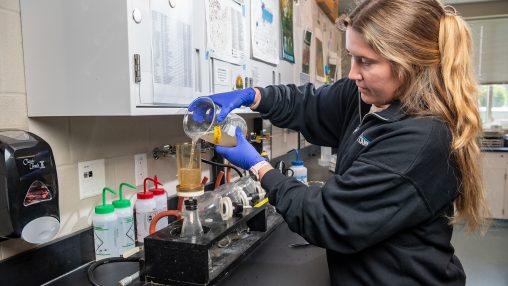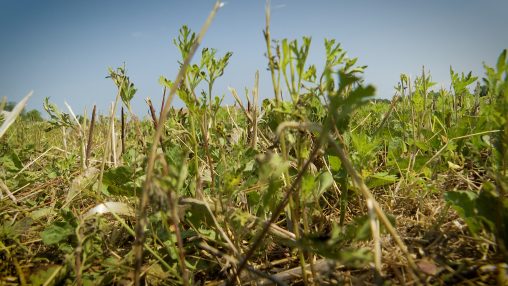Built to transport goods along the Miami Erie Canal in the 1830s, Grand Lake St. Marys, which spans over 13,500 acres, is extremely shallow for its massive size, making it prone to human disturbances.
Over the past decade, unhealthy algae levels in the lake have caused a decrease in wildlife and tourism in the region.
The high algae levels are caused by eutrophication, an overabundance of nutrients — mainly nitrogen and phosphorus — used in agriculture drain into the lake.
Natural wetlands and filter beds around the lake can combat the nutrient runoff problem by absorbing the nutrients before they enter the water.
Stephen Jacquemin, Ph.D., a professor of biology at Wright State University’s Lake Campus, and his students have been conducting water quality testing at Grand Lake St. Marys and surrounding wetlands for almost a decade. Ohio’s wetlands have declined by 90% over the past two centuries and need to be re-established, he said.

Morgan Jutte, a research assistant and lab manager, conducting water quality testing at Lake Campus’ Agriculture and Water Quality Education Center. (Photos Erin Pence)
“They serve a variety of import functions from recharging groundwater to important public recreation outlets,” said Jacquemin, a nationally known expert on watersheds. “We need to restore some of these wetlands, and maybe not every acre will be restored, but there needs to be momentum in the opposite direction.”
About four years ago, Jacquemin proposed a natural wetland site on the north side of Grand St. Marys Lake and adjacent to the Lake Campus to help aid with water runoff. The wetland would also be a convenient location for students to conduct research.
Through a state award called the Clean Ohio Green Space Conservation Program, a 10-acre plot of unused land adjacent to Lake Campus’ Agriculture and Water Quality Education Center will be sold to the Grand Lake St. Marys Lake Facilities Authority to become the future site of a wetland.
“Right now, we are working to get the property surveyed,” said Theresa Dirksen, agricultural and natural resources director of Mercer County.
Dirksen said she hopes the sale agreement will be completed before the end of the year and work to create the wetland will begin next spring.
When completed, the 10-acre wetlands project called the “North Shore Greenspace” will be the first of its kind on the north side of the lake and will impact about 100 acres of watershed draining into Grand Lake St. Marys.
The project will support wildlife and be a research asset for Wright State students pursuing bachelor’s degrees in integrated science and agriculture. The site will contain several pools of water, walking trails and natural grasses.

Ten acres of land located near Lake Campus’ Agriculture and Water Quality Education Center will be converted into a wetland.
“Every little bit helps,” said Dirksen. “It’s also a habitat project, the more diverse types of grasses and terrain and spaces along the open water we can have, the more diversity in wildlife we are going to have as well.”
In 2016, the Coldwater Creek Treatment Train, located about four miles from the Lake Campus along Johnston Road, was completed on the west side of the lake. The 40-acre site filters phosphorus and other nutrients and is home to several large bodies of water, walking trails and wildlife. The construction plans for the Lake Campus wetlands should be similar to those at the Coldwater Creek Treatment Train but on a smaller scale.
Andrea Faber, Ph.D., vice provost and chief administrative officer of Wright State’s Lake Campus, said improving the water quality at Grand Lake St. Marys is instrumental for the community and the region, and Wright State is happy to play a role in its cleanup through research and collaboration with area agencies.
“The partnerships with the agricultural community have been phenomenal,” she said.
Ten years ago, Grand Lake St. Marys was labeled as one of the most polluted lakes in the country from a microcystin algal toxin perspective. A decade of changes in manure management on fields and reconstructed wetlands around the lake have tremendously reduced nitrogen and phosphorus runoff, resulting in less toxicity in the lake in the latest research numbers, Jacquemin said.
Dirksen said the data collected by Wright State students shows that these kind of wetland projects are working and will be valuable as the nutrients flowing into Grand Lake St. Marys continues to decline.
“The lake is improving,” said Dirksen. “We just need to keep the momentum going, and the more we can work with people around the lake the better we’re going to be.”

 Wright State psychology team studies ways to identify fatigue in pilots, drivers
Wright State psychology team studies ways to identify fatigue in pilots, drivers  Wright State videographer Kris Sproles wins Regional Emmy and Ohio journalism award
Wright State videographer Kris Sproles wins Regional Emmy and Ohio journalism award  Wright State Boonshoft School of Medicine ranked among the nation’s best for 2024 by U.S. News
Wright State Boonshoft School of Medicine ranked among the nation’s best for 2024 by U.S. News  Exposing biotechnology
Exposing biotechnology  Wright State faculty member Dan Noel uses unique background to inspire new leaders
Wright State faculty member Dan Noel uses unique background to inspire new leaders 